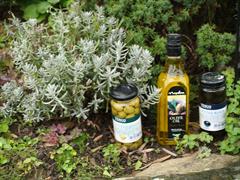How to Grow Olives
 Approximately 20 species, though only O. europea is grown widely throughout the world. The notes below relate to O. europea. It is a small tree with small green, opposite & normally entire leaves. The leaf underside is an attractive silvery colour. Creamy-white small flowers are followed by edible fruit (olive). The olive is grown for its ornamental foliage and edible fruit. It is a tough, long-lived plant in the right conditions. They also make a good hedge or windbreak plant. They can be excellent as a feature plant in a warm position such as a courtyard as long as humidity levels don’t get too high.
Approximately 20 species, though only O. europea is grown widely throughout the world. The notes below relate to O. europea. It is a small tree with small green, opposite & normally entire leaves. The leaf underside is an attractive silvery colour. Creamy-white small flowers are followed by edible fruit (olive). The olive is grown for its ornamental foliage and edible fruit. It is a tough, long-lived plant in the right conditions. They also make a good hedge or windbreak plant. They can be excellent as a feature plant in a warm position such as a courtyard as long as humidity levels don’t get too high.
Olives need good drainage. Sandy loams or sloped slopes are generally preferred. They need a mediterranean type climate - hot and dry with short but reasonably cold winters for best results. The cold of winter helps destroy pests which might otherwise build up to proportions that could seriously damage the trees. Some winter chilling is also necessary for fruit initiation.
Young trees are shaped so they develop 3 to 5 main branches above a clean trunk, after which they are pruned only when necessary (e.g. for shape or to remove dead wood). Organic mulch is useful in colder areas, to protect trees from very cold weather, but in wetter areas a stone or gravel mulch is better to minimise any humidity. Irrigate as necessary to keep soil moist during warmer weather (ie. when putting on growth). Only water sparsely to avoid extreme dryness over winter. They are generally propagated by grafting desired cultivars onto seedling or selected rootstocks. Sometimes fruiting can be irregular (biennial). In such cases fruit or flower thinning may help produce a more even crop each year.
Cultivars
Trees may grow up to 6 to 12 metres tall; though with annual pruning they can easily be kept to 4-6 metres. Trees can take up to 5 years or more before producing a crop, and 10 to 20 years to reach full production; but they can keep bearing for as long as 600 years
There are many different varieties, varying in height, appearance, and most importantly the characteristics of the fruit. The final product (oil or fruit), can vary considerably according to the variety or cultivar grown.
Learn More about Plants through an ACS Plant Variety course.
Click for details: http://www.hortcourses.com/courses/product_listings.aspx?catid=Plant+Varieties
For Australian Native Plants, Click here http://www.hortcourses.com/courses/product_listings.aspx?catid=Australian+Native+Plants
For Our Scented Plants Course click here http://www.hortcourses.com/courses/scented-plants-bht229-209.aspx
You may also be interested in....